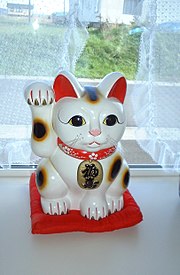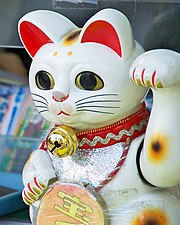Maneki Neko
From Wikipedia, the free encyclopedia
- "Maneki Neko" is also a short story by Bruce Sterling.
The Maneki Neko (招き猫, literally "Beckoning Cat"; also known as Welcoming Cat, Lucky Cat, Money cat or Fortune Cat) is a common Japanese sculpture, often made of porcelain or ceramic, which is believed to bring good luck to the owner. The sculpture depicts a cat (traditionally a Japanese Bobtail) beckoning with an upright paw, and is usually displayed—many times at the entrance—in shops, restaurants, pachinko parlors, and other businesses. Some of the sculptures are electric or battery-powered and have a slow-moving paw beckoning. In the design of the sculptures, a raised right paw supposedly attracts money, while a raised left paw attracts customers.
Maneki Neko come in different colors, styles, and degrees of ornateness. In addition to sculptures, Maneki Neko can be found as keychains, piggy banks, air fresheners, and miscellaneous ornaments.
Contents |
[edit] Common features
[edit] The gesture
To Americans and Europeans it may seem as if the Maneki Neko is waving rather than beckoning. This is due to the difference in gestures and body language recognized by Westerners and the Japanese, with Japanese beckoning by holding up the hand, palm out, and repeatedly folding the fingers down and back up, thus the cat's appearance. Some Maneki Neko made specifically for Western markets will have the cat's paw facing backwards, in a beckoning gesture more familiar to Westerners.[1]
Maneki Neko can be found with either the right or left paw raised (and sometimes both). The significance of the right and left raised paw differs with time and place. The most common belief is that the left paw raised brings in customers, while a right paw brings wealth and good luck, although some believe the opposite. Still others say that a left paw raised is best for drinking establishments, the right paw for other stores. (Those who hold their liquor well are called hidari-kiki in Japan, "left-handed".)[2]
It is commonly believed the higher the raised paw, the greater the luck. Consequently, over the years Maneki Neko's paw has tended to appear ever higher. Some use the paw height as a crude method of gauging the relative age of a figure. Another common belief is that the higher the paw, the greater the distance good fortune will come from.
Some Maneki Neko feature battery- or solar-powered moving arms endlessly engaged in the beckoning gesture.
[edit] Collar, bib and bell
Maneki Neko usually have some sort of decoration around their neck. This can be a neckerchief or a scarf but the most common attire is a collar, bell and decorative bib. These items are most likely in imitation of what was common attire for cats in wealthy households during the Edo period. Red collars made from a red flower, the hichirimen, were popular and small bells were attached for decoration and to keep track of the cat's whereabouts.
The bib might also be related to the bibs often decorating statues of the divinity Jizō Bosatsu. Protective statues of Jizō can be found guarding the entrances to Japanese shrines and graveyards. Jizō is the protector of sick and dying children and grateful parents of children recovered from illness will place a bib around Jizō as a gift of thankfulness.
[edit] The coin
Maneki Neko are sometimes depicted holding a coin; usually a gold coin called a koban, used during the Edo period in Japan. A koban was worth one ryō, another early Japanese monetary unit, though the koban most Maneki Neko hold is indicated to be worth ten million ryō (千万両). A ryō can be imagined as worth a thousand dollars, although the value of the coin, like the value of the dollar, varied considerably.
The coin obviously ties into the cat's part in bringing good fortune and wealth. It is not surprising then that one can often find Maneki Neko used as banks, a practice which goes back at least to the 1890s, much like the Western piggy bank.
Sometimes, pennies and other small coin denominations are left on the Maneki Neko as offerings. This is a practice somewhat related to that of leaving coins in a fountain or wishing well.
[edit] Material
Maneki Neko are typically made of porcelain or ceramic. However, cheaper Maneki Neko can be made of other materials ranging from plastic to wood to papier-mâché to clay, while expensive Maneki Neko may be made of jade or gold. The moving Maneki Neko are usually made of plastic.
[edit] Origins
[edit] History
While it is believed that Maneki Neko first appeared during the later part of the Edo period (1603-1867) in Japan the earliest documentary evidence comes from the 1870s, during Japan's Meiji Era. It is mentioned in a newspaper article in 1876 and there is evidence kimono-clad Maneki Neko were distributed at a shrine in Osaka during this time. An ad from 1902 advertising Maneki Neko indicates that by the turn of the century they were popular.[3]
Beyond that, the exact origins of Maneki Neko are uncertain.
A frequent attribution to several Japanese emperors, as well as to Oda Nobunaga and samurai Ii Naotaka, is that one day the luminary passed by a cat, which seemed to wave to him. Taking the cat's motion as a sign, the unknown nobleman paused and went to it. Diverted from his journey, he realized that he had avoided a trap that had been laid for him just ahead. Since that time, cats have been considered wise and lucky spirits. Many Japanese shrines and homes include the figurine of a cat with one paw upraised as if waving—hence the origin of Maneki Neko, often referred to as Kami Neko in reference to the cat's kami or spirit.
Others have noted the similarities between the Maneki Neko's gesture and that of a cat washing its face. There is a Japanese belief that a cat washing its face means a visitor will soon arrive. This belief may in turn be related to an even older Chinese proverb that states that if a cat washes its face, it will rain. Thus it is possible a belief arose that a figure of a cat washing its face would bring in customers.
It is unknown how the Maneki Neko became popular in the United States, but they were known in the U.S. at least in 1963, when Patricia Dale-Green wrote of them in The Cult of the Cat. They were most likely introduced to the United States by Japanese immigrants.
[edit] Legends and stories
Maneki Neko is the subject of a number of legends. Here are three of the most popular, explaining the cat's origins:
The Temple Cat: This story goes that a wealthy feudal lord was taking shelter under a tree near Gotoku-ji temple (in Western Tokyo) during a thunderstorm. The lord saw the temple priest's cat beckoning to him and followed; a moment later the tree was struck by lightning. The wealthy man became friends with the poor priest and the temple became prosperous. When the cat died, supposedly the first Maneki Neko was made in his honor.
The Courtesan: A courtesan named Usugumo, living in Yoshiwara, in eastern Tokyo, kept a cat, much beloved by her. One night, the cat began tugging at her kimono. No matter what she did, the cat persisted. The owner of the brothel saw this, and believing the cat bewitched, cut its head off. The cat's head then flew to the ceiling where it killed a snake, ready at any moment to strike. Usugumo was devastated by the death of her companion. To cheer her up, one of her customers made her a wooden likeness of her cat as a gift. This cat image then became popular as the Maneki Neko.
The Old Woman: An old woman living in Imado (eastern Tokyo) was forced to sell her cat due to extreme poverty. Soon afterwards the cat appeared to her in a dream. The cat told her to make its image in clay. She did as instructed, and soon afterward sold the statue. She then made more, and people bought them as well. They were so popular she soon became prosperous and wealthy.[4]
[edit] Influence
Such is the influence of the Maneki Neko as a cultural icon that many other characters and cultural imagery are derived from it.
- The Thai prosperity goddess Nang Kwak has adapted the beckoning gesture of the Maneki Neko.
- An NGO group working in Ukraine ran a poster campaign with the photograph of Maneki Neko to promote a fair election process.
- SF author Bruce Sterling wrote a story, "Maneki Neko," in which the cat-paw gesture is the sign of a secret AI-based barter network.
- The American rock band Weezer have Maneki Neko on the cover of their EP The Lion and the Witch. The songs on the album were recorded live in Japan.
- Frank Black and the Catholics have a Maneki Neko on the cover of their 2003 album Show Me Your Tears incongruously placed next to a slide guitar.
- The Pokémon Meowth is designed to look like a Maneki Neko.
- Trophy Scars have Maneki Neko on the cover of their album "Alphabet. Alphabets.."
- ISAN, a British electronic duo, have an album called "Lucky Cat".
- There is a character in the Japanese SNES role-playing game, "Secret of Mana" named 'Neko'. Neko is an anthropomorphic cat trader who appears throughout the game, some say he is very wealthy.
[edit] See also
- Three-legged money frog
- Tama (cat), a living Maneki Neko who is the station master of the Wakayama Electric Railway
[edit] References
- Dale-Green, Patricia, The Cult of the Cat (Houghton Mifflin, Boston, 1963).
- Daniels, Inge Maria, 2003. Scooping, raking, beckoning luck: luck, agency and the interdependence of people and things in Japan. Royal Anthropological Institute 9 (4), 619-638.
- Wellman, Laurel, Lucky Cat: He Brings You Good Luck (Chronicle Books, San Francisco, 2004).



